CHCCSM005: Developing, Facilitating, and Reviewing Case Management
VerifiedAdded on 2023/06/13
|26
|8804
|320
Report
AI Summary
This report provides a comprehensive overview of case management, addressing key aspects such as mental health treatment, client involvement, cultural considerations, and complaint avenues. It details the importance of formal meetings, record-keeping, and supporting client rights. The report explores strength-based, right-based, person-centered, and need-based approaches to case management, emphasizing the development of action plans and the involvement of stakeholders. Monitoring strategies, risk assessment techniques, and strategies for dealing with complex situations are also discussed. The document concludes by highlighting the significance of performance evaluation and adherence to organizational procedures, offering a thorough understanding of effective case management practices.
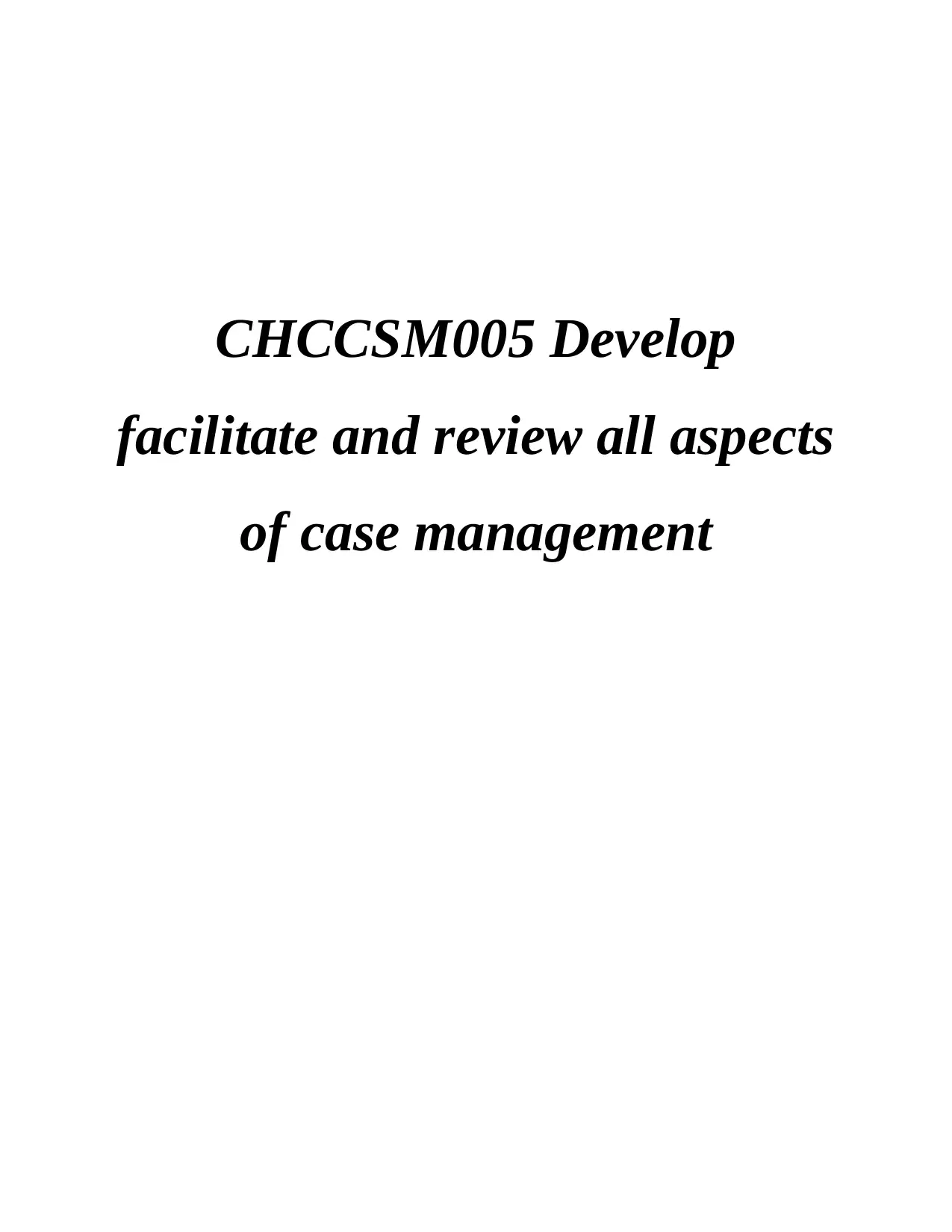
CHCCSM005 Develop
facilitate and review all aspects
of case management
facilitate and review all aspects
of case management
Paraphrase This Document
Need a fresh take? Get an instant paraphrase of this document with our AI Paraphraser
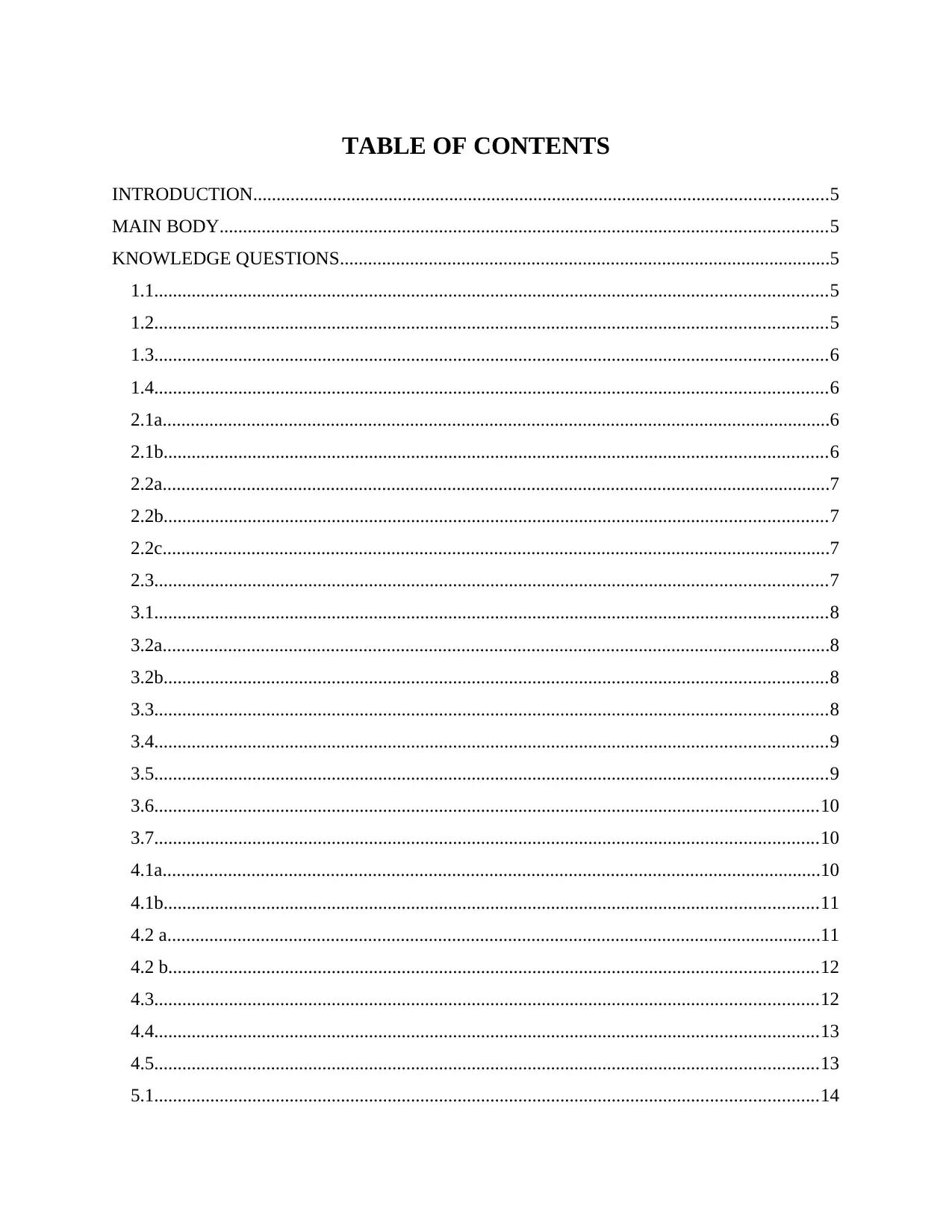
TABLE OF CONTENTS
INTRODUCTION...........................................................................................................................5
MAIN BODY..................................................................................................................................5
KNOWLEDGE QUESTIONS.........................................................................................................5
1.1................................................................................................................................................5
1.2................................................................................................................................................5
1.3................................................................................................................................................6
1.4................................................................................................................................................6
2.1a...............................................................................................................................................6
2.1b..............................................................................................................................................6
2.2a...............................................................................................................................................7
2.2b..............................................................................................................................................7
2.2c...............................................................................................................................................7
2.3................................................................................................................................................7
3.1................................................................................................................................................8
3.2a...............................................................................................................................................8
3.2b..............................................................................................................................................8
3.3................................................................................................................................................8
3.4................................................................................................................................................9
3.5................................................................................................................................................9
3.6..............................................................................................................................................10
3.7..............................................................................................................................................10
4.1a.............................................................................................................................................10
4.1b............................................................................................................................................11
4.2 a............................................................................................................................................11
4.2 b...........................................................................................................................................12
4.3..............................................................................................................................................12
4.4..............................................................................................................................................13
4.5..............................................................................................................................................13
5.1..............................................................................................................................................14
INTRODUCTION...........................................................................................................................5
MAIN BODY..................................................................................................................................5
KNOWLEDGE QUESTIONS.........................................................................................................5
1.1................................................................................................................................................5
1.2................................................................................................................................................5
1.3................................................................................................................................................6
1.4................................................................................................................................................6
2.1a...............................................................................................................................................6
2.1b..............................................................................................................................................6
2.2a...............................................................................................................................................7
2.2b..............................................................................................................................................7
2.2c...............................................................................................................................................7
2.3................................................................................................................................................7
3.1................................................................................................................................................8
3.2a...............................................................................................................................................8
3.2b..............................................................................................................................................8
3.3................................................................................................................................................8
3.4................................................................................................................................................9
3.5................................................................................................................................................9
3.6..............................................................................................................................................10
3.7..............................................................................................................................................10
4.1a.............................................................................................................................................10
4.1b............................................................................................................................................11
4.2 a............................................................................................................................................11
4.2 b...........................................................................................................................................12
4.3..............................................................................................................................................12
4.4..............................................................................................................................................13
4.5..............................................................................................................................................13
5.1..............................................................................................................................................14
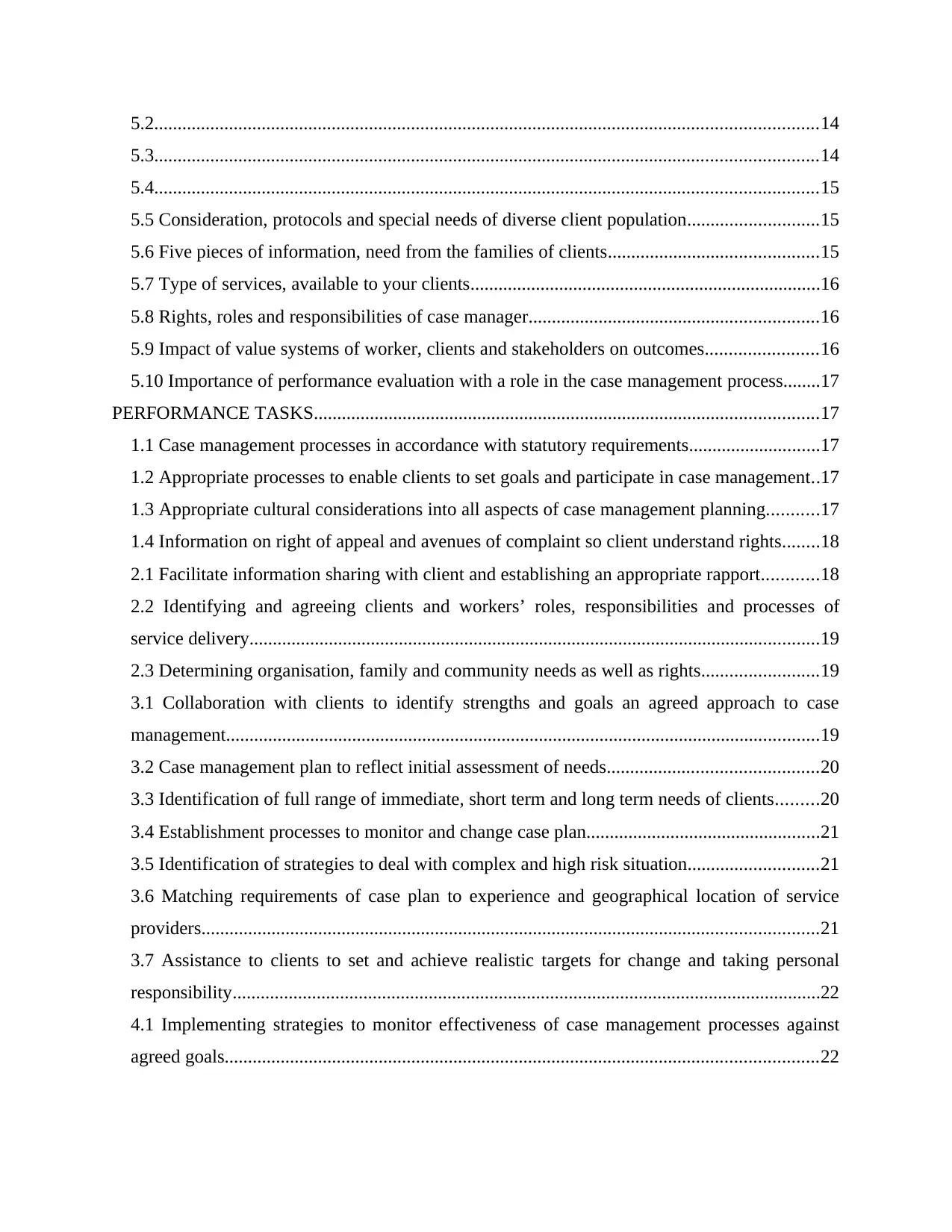
5.2..............................................................................................................................................14
5.3..............................................................................................................................................14
5.4..............................................................................................................................................15
5.5 Consideration, protocols and special needs of diverse client population............................15
5.6 Five pieces of information, need from the families of clients.............................................15
5.7 Type of services, available to your clients...........................................................................16
5.8 Rights, roles and responsibilities of case manager..............................................................16
5.9 Impact of value systems of worker, clients and stakeholders on outcomes........................16
5.10 Importance of performance evaluation with a role in the case management process........17
PERFORMANCE TASKS............................................................................................................17
1.1 Case management processes in accordance with statutory requirements............................17
1.2 Appropriate processes to enable clients to set goals and participate in case management..17
1.3 Appropriate cultural considerations into all aspects of case management planning...........17
1.4 Information on right of appeal and avenues of complaint so client understand rights........18
2.1 Facilitate information sharing with client and establishing an appropriate rapport............18
2.2 Identifying and agreeing clients and workers’ roles, responsibilities and processes of
service delivery..........................................................................................................................19
2.3 Determining organisation, family and community needs as well as rights.........................19
3.1 Collaboration with clients to identify strengths and goals an agreed approach to case
management...............................................................................................................................19
3.2 Case management plan to reflect initial assessment of needs.............................................20
3.3 Identification of full range of immediate, short term and long term needs of clients.........20
3.4 Establishment processes to monitor and change case plan..................................................21
3.5 Identification of strategies to deal with complex and high risk situation............................21
3.6 Matching requirements of case plan to experience and geographical location of service
providers....................................................................................................................................21
3.7 Assistance to clients to set and achieve realistic targets for change and taking personal
responsibility..............................................................................................................................22
4.1 Implementing strategies to monitor effectiveness of case management processes against
agreed goals...............................................................................................................................22
5.3..............................................................................................................................................14
5.4..............................................................................................................................................15
5.5 Consideration, protocols and special needs of diverse client population............................15
5.6 Five pieces of information, need from the families of clients.............................................15
5.7 Type of services, available to your clients...........................................................................16
5.8 Rights, roles and responsibilities of case manager..............................................................16
5.9 Impact of value systems of worker, clients and stakeholders on outcomes........................16
5.10 Importance of performance evaluation with a role in the case management process........17
PERFORMANCE TASKS............................................................................................................17
1.1 Case management processes in accordance with statutory requirements............................17
1.2 Appropriate processes to enable clients to set goals and participate in case management..17
1.3 Appropriate cultural considerations into all aspects of case management planning...........17
1.4 Information on right of appeal and avenues of complaint so client understand rights........18
2.1 Facilitate information sharing with client and establishing an appropriate rapport............18
2.2 Identifying and agreeing clients and workers’ roles, responsibilities and processes of
service delivery..........................................................................................................................19
2.3 Determining organisation, family and community needs as well as rights.........................19
3.1 Collaboration with clients to identify strengths and goals an agreed approach to case
management...............................................................................................................................19
3.2 Case management plan to reflect initial assessment of needs.............................................20
3.3 Identification of full range of immediate, short term and long term needs of clients.........20
3.4 Establishment processes to monitor and change case plan..................................................21
3.5 Identification of strategies to deal with complex and high risk situation............................21
3.6 Matching requirements of case plan to experience and geographical location of service
providers....................................................................................................................................21
3.7 Assistance to clients to set and achieve realistic targets for change and taking personal
responsibility..............................................................................................................................22
4.1 Implementing strategies to monitor effectiveness of case management processes against
agreed goals...............................................................................................................................22
⊘ This is a preview!⊘
Do you want full access?
Subscribe today to unlock all pages.

Trusted by 1+ million students worldwide
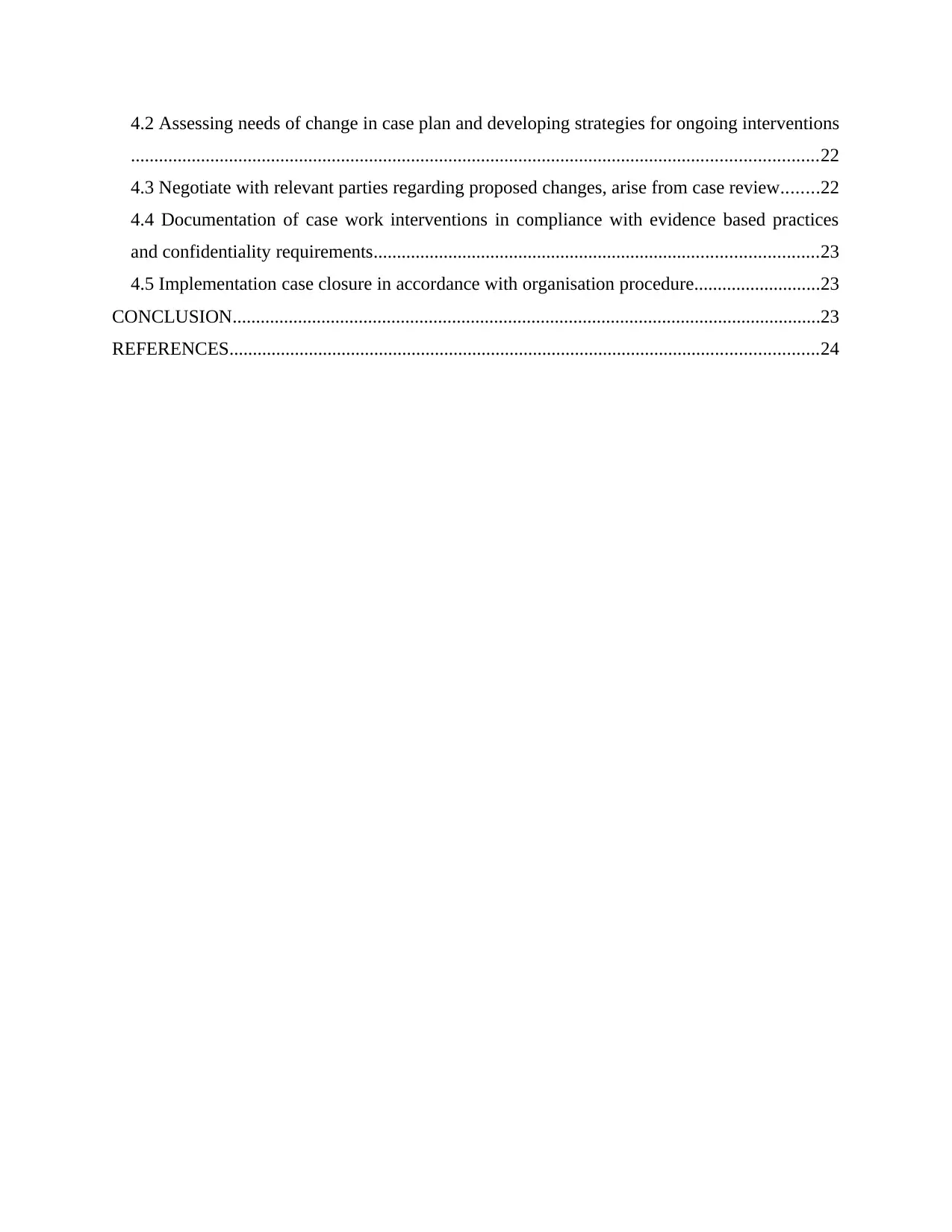
4.2 Assessing needs of change in case plan and developing strategies for ongoing interventions
...................................................................................................................................................22
4.3 Negotiate with relevant parties regarding proposed changes, arise from case review........22
4.4 Documentation of case work interventions in compliance with evidence based practices
and confidentiality requirements...............................................................................................23
4.5 Implementation case closure in accordance with organisation procedure...........................23
CONCLUSION..............................................................................................................................23
REFERENCES..............................................................................................................................24
...................................................................................................................................................22
4.3 Negotiate with relevant parties regarding proposed changes, arise from case review........22
4.4 Documentation of case work interventions in compliance with evidence based practices
and confidentiality requirements...............................................................................................23
4.5 Implementation case closure in accordance with organisation procedure...........................23
CONCLUSION..............................................................................................................................23
REFERENCES..............................................................................................................................24
Paraphrase This Document
Need a fresh take? Get an instant paraphrase of this document with our AI Paraphraser
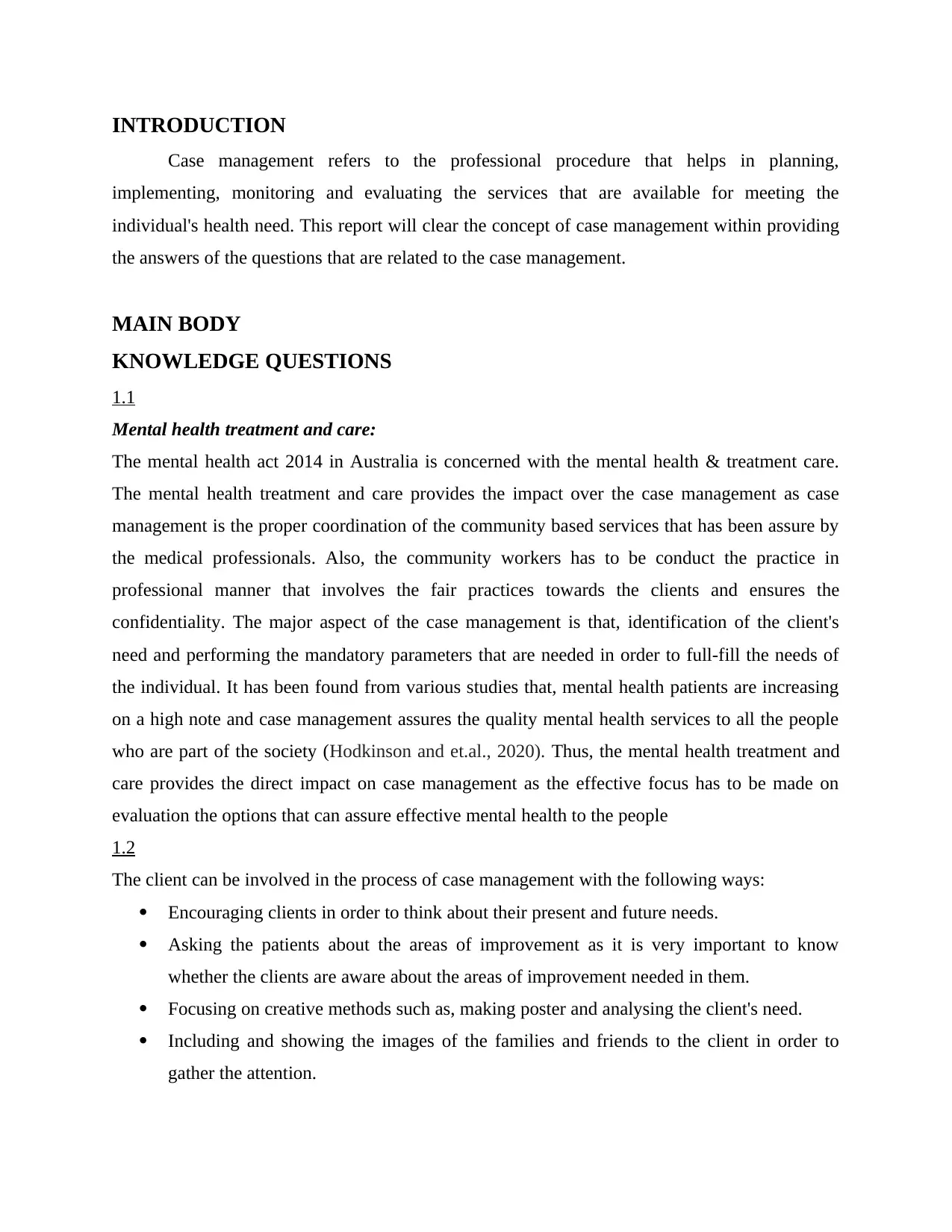
INTRODUCTION
Case management refers to the professional procedure that helps in planning,
implementing, monitoring and evaluating the services that are available for meeting the
individual's health need. This report will clear the concept of case management within providing
the answers of the questions that are related to the case management.
MAIN BODY
KNOWLEDGE QUESTIONS
1.1
Mental health treatment and care:
The mental health act 2014 in Australia is concerned with the mental health & treatment care.
The mental health treatment and care provides the impact over the case management as case
management is the proper coordination of the community based services that has been assure by
the medical professionals. Also, the community workers has to be conduct the practice in
professional manner that involves the fair practices towards the clients and ensures the
confidentiality. The major aspect of the case management is that, identification of the client's
need and performing the mandatory parameters that are needed in order to full-fill the needs of
the individual. It has been found from various studies that, mental health patients are increasing
on a high note and case management assures the quality mental health services to all the people
who are part of the society (Hodkinson and et.al., 2020). Thus, the mental health treatment and
care provides the direct impact on case management as the effective focus has to be made on
evaluation the options that can assure effective mental health to the people
1.2
The client can be involved in the process of case management with the following ways:
Encouraging clients in order to think about their present and future needs.
Asking the patients about the areas of improvement as it is very important to know
whether the clients are aware about the areas of improvement needed in them.
Focusing on creative methods such as, making poster and analysing the client's need.
Including and showing the images of the families and friends to the client in order to
gather the attention.
Case management refers to the professional procedure that helps in planning,
implementing, monitoring and evaluating the services that are available for meeting the
individual's health need. This report will clear the concept of case management within providing
the answers of the questions that are related to the case management.
MAIN BODY
KNOWLEDGE QUESTIONS
1.1
Mental health treatment and care:
The mental health act 2014 in Australia is concerned with the mental health & treatment care.
The mental health treatment and care provides the impact over the case management as case
management is the proper coordination of the community based services that has been assure by
the medical professionals. Also, the community workers has to be conduct the practice in
professional manner that involves the fair practices towards the clients and ensures the
confidentiality. The major aspect of the case management is that, identification of the client's
need and performing the mandatory parameters that are needed in order to full-fill the needs of
the individual. It has been found from various studies that, mental health patients are increasing
on a high note and case management assures the quality mental health services to all the people
who are part of the society (Hodkinson and et.al., 2020). Thus, the mental health treatment and
care provides the direct impact on case management as the effective focus has to be made on
evaluation the options that can assure effective mental health to the people
1.2
The client can be involved in the process of case management with the following ways:
Encouraging clients in order to think about their present and future needs.
Asking the patients about the areas of improvement as it is very important to know
whether the clients are aware about the areas of improvement needed in them.
Focusing on creative methods such as, making poster and analysing the client's need.
Including and showing the images of the families and friends to the client in order to
gather the attention.
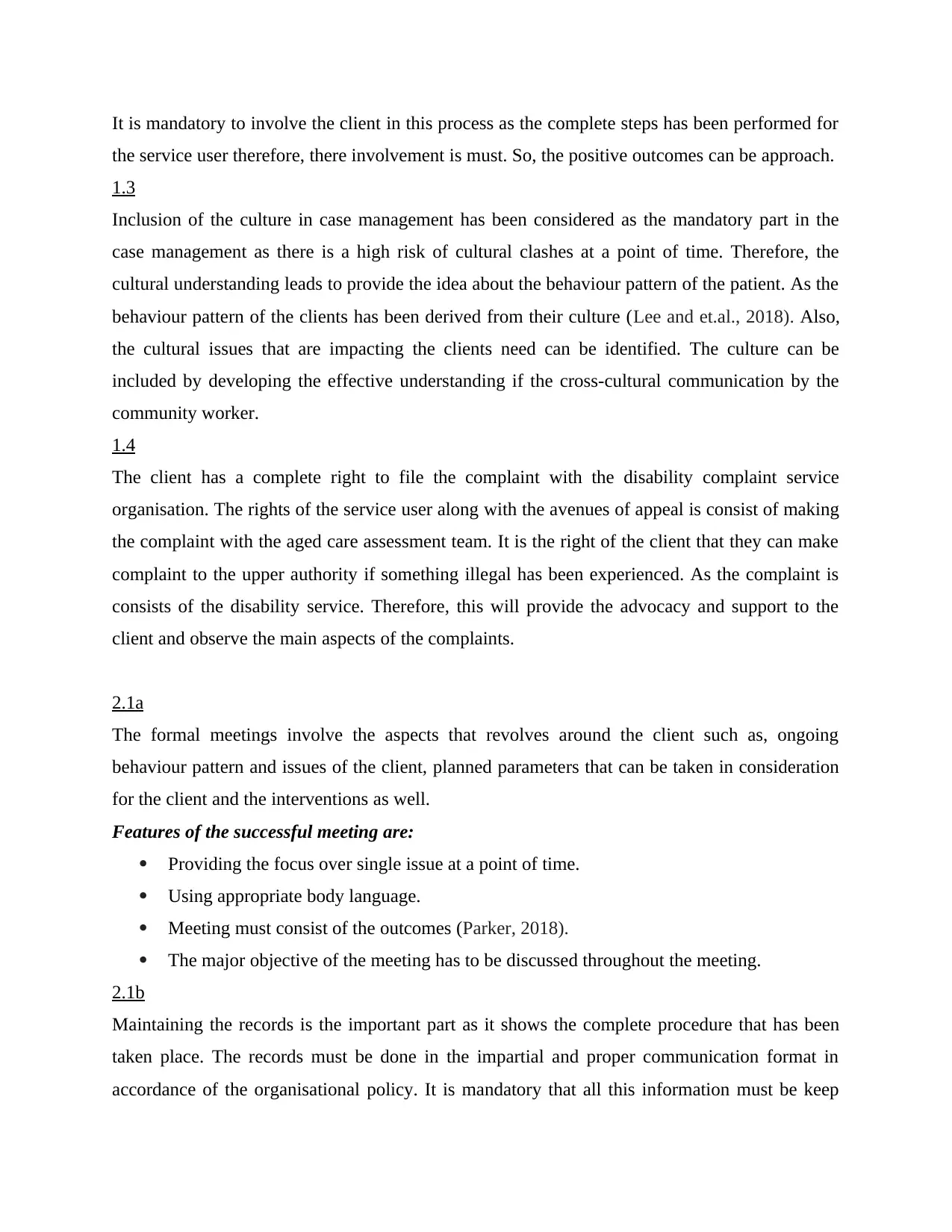
It is mandatory to involve the client in this process as the complete steps has been performed for
the service user therefore, there involvement is must. So, the positive outcomes can be approach.
1.3
Inclusion of the culture in case management has been considered as the mandatory part in the
case management as there is a high risk of cultural clashes at a point of time. Therefore, the
cultural understanding leads to provide the idea about the behaviour pattern of the patient. As the
behaviour pattern of the clients has been derived from their culture (Lee and et.al., 2018). Also,
the cultural issues that are impacting the clients need can be identified. The culture can be
included by developing the effective understanding if the cross-cultural communication by the
community worker.
1.4
The client has a complete right to file the complaint with the disability complaint service
organisation. The rights of the service user along with the avenues of appeal is consist of making
the complaint with the aged care assessment team. It is the right of the client that they can make
complaint to the upper authority if something illegal has been experienced. As the complaint is
consists of the disability service. Therefore, this will provide the advocacy and support to the
client and observe the main aspects of the complaints.
2.1a
The formal meetings involve the aspects that revolves around the client such as, ongoing
behaviour pattern and issues of the client, planned parameters that can be taken in consideration
for the client and the interventions as well.
Features of the successful meeting are:
Providing the focus over single issue at a point of time.
Using appropriate body language.
Meeting must consist of the outcomes (Parker, 2018).
The major objective of the meeting has to be discussed throughout the meeting.
2.1b
Maintaining the records is the important part as it shows the complete procedure that has been
taken place. The records must be done in the impartial and proper communication format in
accordance of the organisational policy. It is mandatory that all this information must be keep
the service user therefore, there involvement is must. So, the positive outcomes can be approach.
1.3
Inclusion of the culture in case management has been considered as the mandatory part in the
case management as there is a high risk of cultural clashes at a point of time. Therefore, the
cultural understanding leads to provide the idea about the behaviour pattern of the patient. As the
behaviour pattern of the clients has been derived from their culture (Lee and et.al., 2018). Also,
the cultural issues that are impacting the clients need can be identified. The culture can be
included by developing the effective understanding if the cross-cultural communication by the
community worker.
1.4
The client has a complete right to file the complaint with the disability complaint service
organisation. The rights of the service user along with the avenues of appeal is consist of making
the complaint with the aged care assessment team. It is the right of the client that they can make
complaint to the upper authority if something illegal has been experienced. As the complaint is
consists of the disability service. Therefore, this will provide the advocacy and support to the
client and observe the main aspects of the complaints.
2.1a
The formal meetings involve the aspects that revolves around the client such as, ongoing
behaviour pattern and issues of the client, planned parameters that can be taken in consideration
for the client and the interventions as well.
Features of the successful meeting are:
Providing the focus over single issue at a point of time.
Using appropriate body language.
Meeting must consist of the outcomes (Parker, 2018).
The major objective of the meeting has to be discussed throughout the meeting.
2.1b
Maintaining the records is the important part as it shows the complete procedure that has been
taken place. The records must be done in the impartial and proper communication format in
accordance of the organisational policy. It is mandatory that all this information must be keep
⊘ This is a preview!⊘
Do you want full access?
Subscribe today to unlock all pages.

Trusted by 1+ million students worldwide
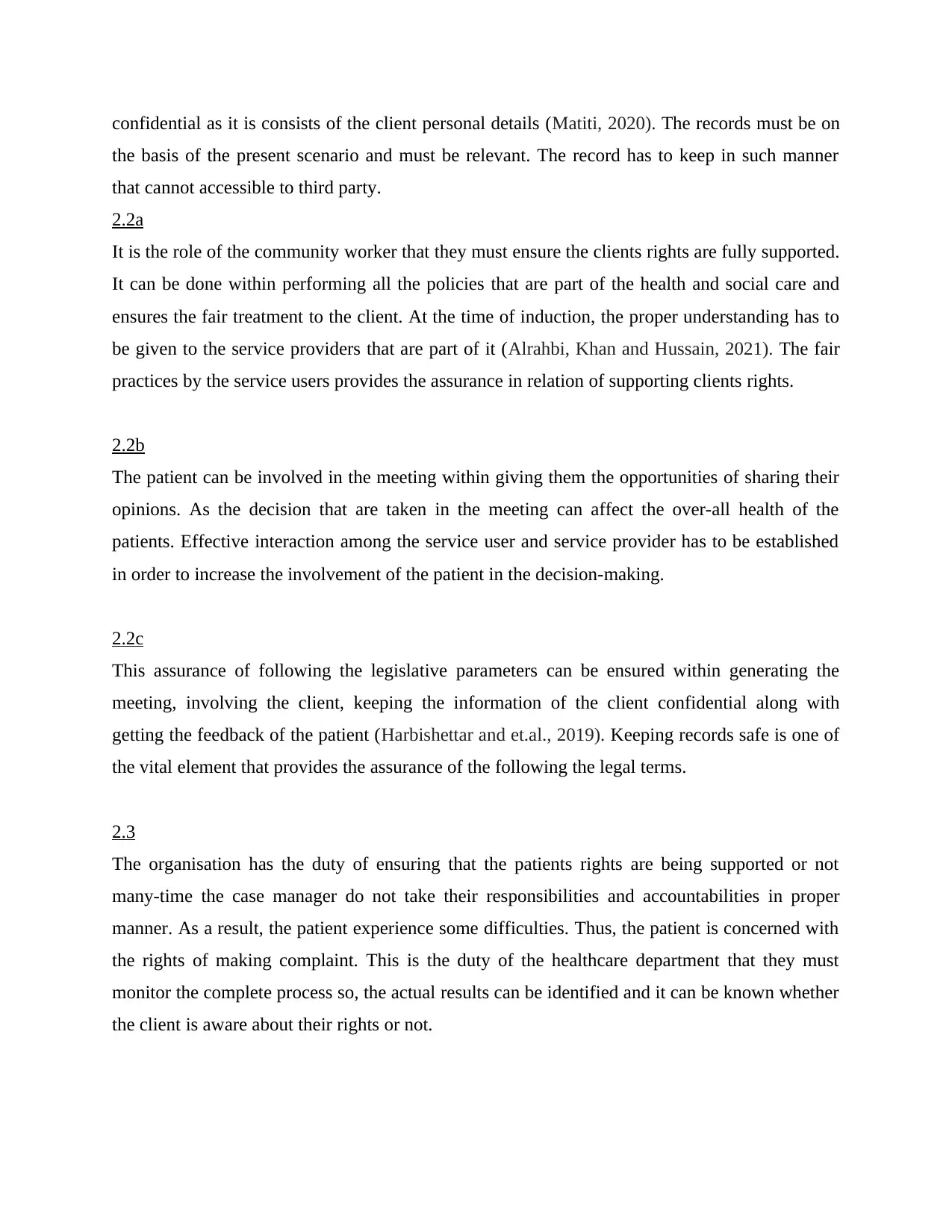
confidential as it is consists of the client personal details (Matiti, 2020). The records must be on
the basis of the present scenario and must be relevant. The record has to keep in such manner
that cannot accessible to third party.
2.2a
It is the role of the community worker that they must ensure the clients rights are fully supported.
It can be done within performing all the policies that are part of the health and social care and
ensures the fair treatment to the client. At the time of induction, the proper understanding has to
be given to the service providers that are part of it (Alrahbi, Khan and Hussain, 2021). The fair
practices by the service users provides the assurance in relation of supporting clients rights.
2.2b
The patient can be involved in the meeting within giving them the opportunities of sharing their
opinions. As the decision that are taken in the meeting can affect the over-all health of the
patients. Effective interaction among the service user and service provider has to be established
in order to increase the involvement of the patient in the decision-making.
2.2c
This assurance of following the legislative parameters can be ensured within generating the
meeting, involving the client, keeping the information of the client confidential along with
getting the feedback of the patient (Harbishettar and et.al., 2019). Keeping records safe is one of
the vital element that provides the assurance of the following the legal terms.
2.3
The organisation has the duty of ensuring that the patients rights are being supported or not
many-time the case manager do not take their responsibilities and accountabilities in proper
manner. As a result, the patient experience some difficulties. Thus, the patient is concerned with
the rights of making complaint. This is the duty of the healthcare department that they must
monitor the complete process so, the actual results can be identified and it can be known whether
the client is aware about their rights or not.
the basis of the present scenario and must be relevant. The record has to keep in such manner
that cannot accessible to third party.
2.2a
It is the role of the community worker that they must ensure the clients rights are fully supported.
It can be done within performing all the policies that are part of the health and social care and
ensures the fair treatment to the client. At the time of induction, the proper understanding has to
be given to the service providers that are part of it (Alrahbi, Khan and Hussain, 2021). The fair
practices by the service users provides the assurance in relation of supporting clients rights.
2.2b
The patient can be involved in the meeting within giving them the opportunities of sharing their
opinions. As the decision that are taken in the meeting can affect the over-all health of the
patients. Effective interaction among the service user and service provider has to be established
in order to increase the involvement of the patient in the decision-making.
2.2c
This assurance of following the legislative parameters can be ensured within generating the
meeting, involving the client, keeping the information of the client confidential along with
getting the feedback of the patient (Harbishettar and et.al., 2019). Keeping records safe is one of
the vital element that provides the assurance of the following the legal terms.
2.3
The organisation has the duty of ensuring that the patients rights are being supported or not
many-time the case manager do not take their responsibilities and accountabilities in proper
manner. As a result, the patient experience some difficulties. Thus, the patient is concerned with
the rights of making complaint. This is the duty of the healthcare department that they must
monitor the complete process so, the actual results can be identified and it can be known whether
the client is aware about their rights or not.
Paraphrase This Document
Need a fresh take? Get an instant paraphrase of this document with our AI Paraphraser
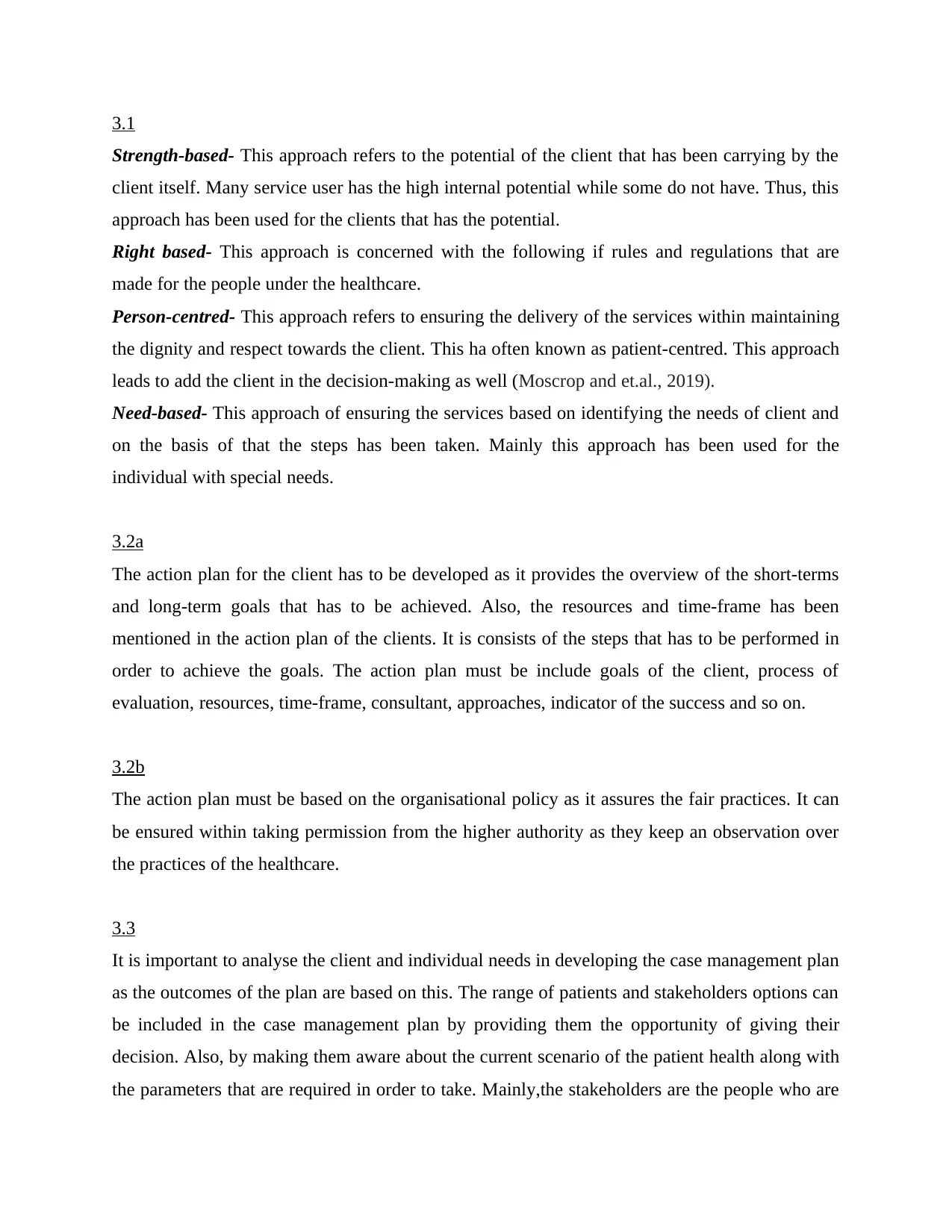
3.1
Strength-based- This approach refers to the potential of the client that has been carrying by the
client itself. Many service user has the high internal potential while some do not have. Thus, this
approach has been used for the clients that has the potential.
Right based- This approach is concerned with the following if rules and regulations that are
made for the people under the healthcare.
Person-centred- This approach refers to ensuring the delivery of the services within maintaining
the dignity and respect towards the client. This ha often known as patient-centred. This approach
leads to add the client in the decision-making as well (Moscrop and et.al., 2019).
Need-based- This approach of ensuring the services based on identifying the needs of client and
on the basis of that the steps has been taken. Mainly this approach has been used for the
individual with special needs.
3.2a
The action plan for the client has to be developed as it provides the overview of the short-terms
and long-term goals that has to be achieved. Also, the resources and time-frame has been
mentioned in the action plan of the clients. It is consists of the steps that has to be performed in
order to achieve the goals. The action plan must be include goals of the client, process of
evaluation, resources, time-frame, consultant, approaches, indicator of the success and so on.
3.2b
The action plan must be based on the organisational policy as it assures the fair practices. It can
be ensured within taking permission from the higher authority as they keep an observation over
the practices of the healthcare.
3.3
It is important to analyse the client and individual needs in developing the case management plan
as the outcomes of the plan are based on this. The range of patients and stakeholders options can
be included in the case management plan by providing them the opportunity of giving their
decision. Also, by making them aware about the current scenario of the patient health along with
the parameters that are required in order to take. Mainly,the stakeholders are the people who are
Strength-based- This approach refers to the potential of the client that has been carrying by the
client itself. Many service user has the high internal potential while some do not have. Thus, this
approach has been used for the clients that has the potential.
Right based- This approach is concerned with the following if rules and regulations that are
made for the people under the healthcare.
Person-centred- This approach refers to ensuring the delivery of the services within maintaining
the dignity and respect towards the client. This ha often known as patient-centred. This approach
leads to add the client in the decision-making as well (Moscrop and et.al., 2019).
Need-based- This approach of ensuring the services based on identifying the needs of client and
on the basis of that the steps has been taken. Mainly this approach has been used for the
individual with special needs.
3.2a
The action plan for the client has to be developed as it provides the overview of the short-terms
and long-term goals that has to be achieved. Also, the resources and time-frame has been
mentioned in the action plan of the clients. It is consists of the steps that has to be performed in
order to achieve the goals. The action plan must be include goals of the client, process of
evaluation, resources, time-frame, consultant, approaches, indicator of the success and so on.
3.2b
The action plan must be based on the organisational policy as it assures the fair practices. It can
be ensured within taking permission from the higher authority as they keep an observation over
the practices of the healthcare.
3.3
It is important to analyse the client and individual needs in developing the case management plan
as the outcomes of the plan are based on this. The range of patients and stakeholders options can
be included in the case management plan by providing them the opportunity of giving their
decision. Also, by making them aware about the current scenario of the patient health along with
the parameters that are required in order to take. Mainly,the stakeholders are the people who are
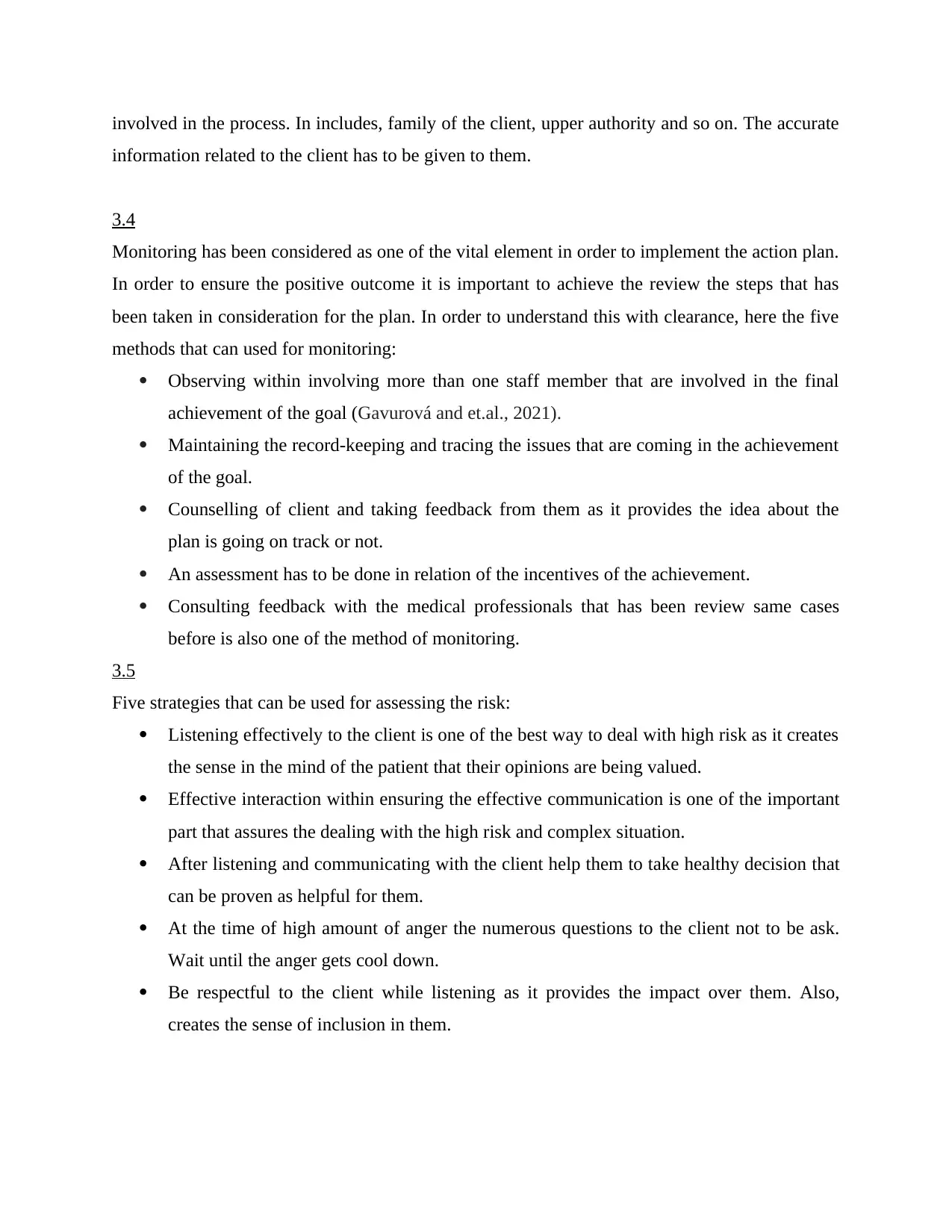
involved in the process. In includes, family of the client, upper authority and so on. The accurate
information related to the client has to be given to them.
3.4
Monitoring has been considered as one of the vital element in order to implement the action plan.
In order to ensure the positive outcome it is important to achieve the review the steps that has
been taken in consideration for the plan. In order to understand this with clearance, here the five
methods that can used for monitoring:
Observing within involving more than one staff member that are involved in the final
achievement of the goal (Gavurová and et.al., 2021).
Maintaining the record-keeping and tracing the issues that are coming in the achievement
of the goal.
Counselling of client and taking feedback from them as it provides the idea about the
plan is going on track or not.
An assessment has to be done in relation of the incentives of the achievement.
Consulting feedback with the medical professionals that has been review same cases
before is also one of the method of monitoring.
3.5
Five strategies that can be used for assessing the risk:
Listening effectively to the client is one of the best way to deal with high risk as it creates
the sense in the mind of the patient that their opinions are being valued.
Effective interaction within ensuring the effective communication is one of the important
part that assures the dealing with the high risk and complex situation.
After listening and communicating with the client help them to take healthy decision that
can be proven as helpful for them.
At the time of high amount of anger the numerous questions to the client not to be ask.
Wait until the anger gets cool down.
Be respectful to the client while listening as it provides the impact over them. Also,
creates the sense of inclusion in them.
information related to the client has to be given to them.
3.4
Monitoring has been considered as one of the vital element in order to implement the action plan.
In order to ensure the positive outcome it is important to achieve the review the steps that has
been taken in consideration for the plan. In order to understand this with clearance, here the five
methods that can used for monitoring:
Observing within involving more than one staff member that are involved in the final
achievement of the goal (Gavurová and et.al., 2021).
Maintaining the record-keeping and tracing the issues that are coming in the achievement
of the goal.
Counselling of client and taking feedback from them as it provides the idea about the
plan is going on track or not.
An assessment has to be done in relation of the incentives of the achievement.
Consulting feedback with the medical professionals that has been review same cases
before is also one of the method of monitoring.
3.5
Five strategies that can be used for assessing the risk:
Listening effectively to the client is one of the best way to deal with high risk as it creates
the sense in the mind of the patient that their opinions are being valued.
Effective interaction within ensuring the effective communication is one of the important
part that assures the dealing with the high risk and complex situation.
After listening and communicating with the client help them to take healthy decision that
can be proven as helpful for them.
At the time of high amount of anger the numerous questions to the client not to be ask.
Wait until the anger gets cool down.
Be respectful to the client while listening as it provides the impact over them. Also,
creates the sense of inclusion in them.
⊘ This is a preview!⊘
Do you want full access?
Subscribe today to unlock all pages.

Trusted by 1+ million students worldwide
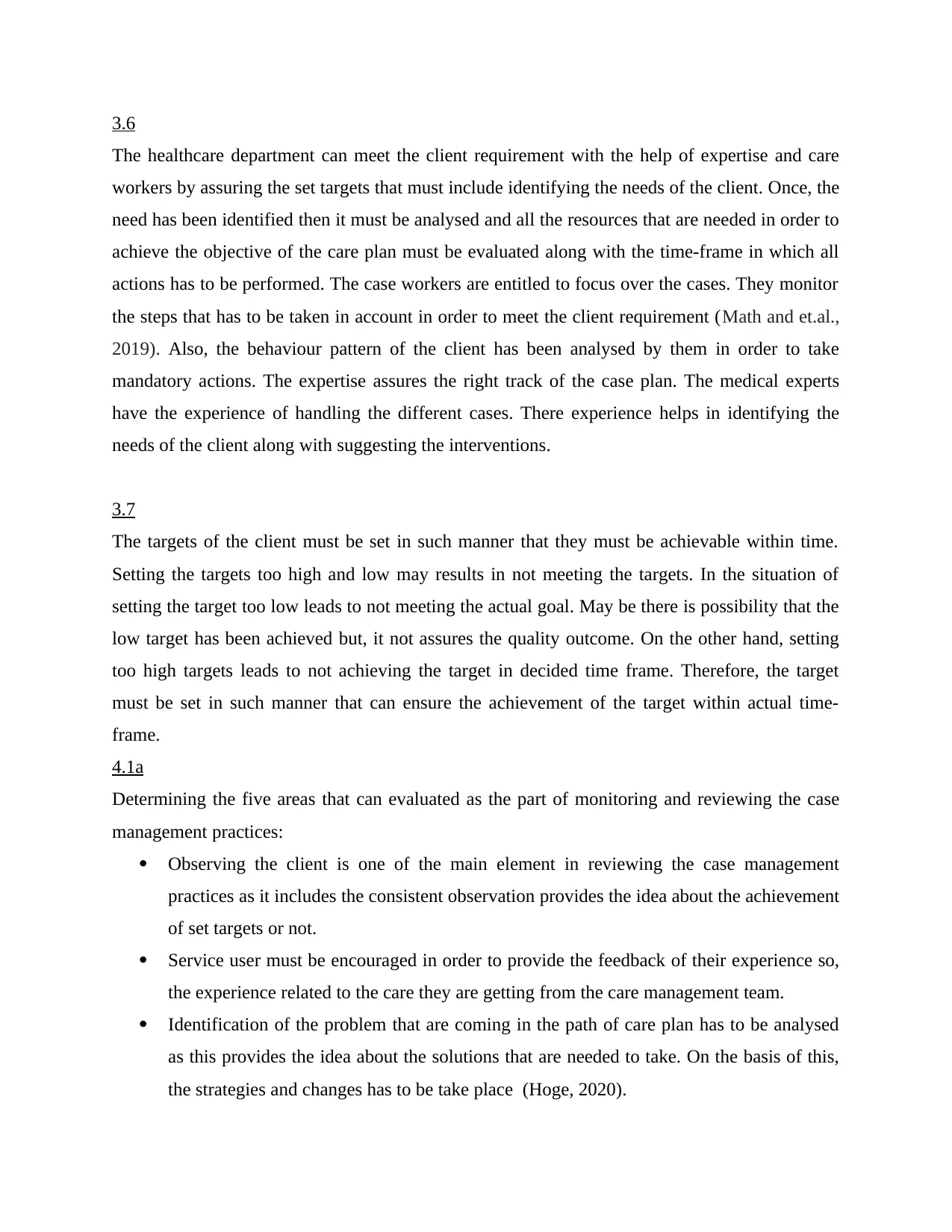
3.6
The healthcare department can meet the client requirement with the help of expertise and care
workers by assuring the set targets that must include identifying the needs of the client. Once, the
need has been identified then it must be analysed and all the resources that are needed in order to
achieve the objective of the care plan must be evaluated along with the time-frame in which all
actions has to be performed. The case workers are entitled to focus over the cases. They monitor
the steps that has to be taken in account in order to meet the client requirement (Math and et.al.,
2019). Also, the behaviour pattern of the client has been analysed by them in order to take
mandatory actions. The expertise assures the right track of the case plan. The medical experts
have the experience of handling the different cases. There experience helps in identifying the
needs of the client along with suggesting the interventions.
3.7
The targets of the client must be set in such manner that they must be achievable within time.
Setting the targets too high and low may results in not meeting the targets. In the situation of
setting the target too low leads to not meeting the actual goal. May be there is possibility that the
low target has been achieved but, it not assures the quality outcome. On the other hand, setting
too high targets leads to not achieving the target in decided time frame. Therefore, the target
must be set in such manner that can ensure the achievement of the target within actual time-
frame.
4.1a
Determining the five areas that can evaluated as the part of monitoring and reviewing the case
management practices:
Observing the client is one of the main element in reviewing the case management
practices as it includes the consistent observation provides the idea about the achievement
of set targets or not.
Service user must be encouraged in order to provide the feedback of their experience so,
the experience related to the care they are getting from the care management team.
Identification of the problem that are coming in the path of care plan has to be analysed
as this provides the idea about the solutions that are needed to take. On the basis of this,
the strategies and changes has to be take place (Hoge, 2020).
The healthcare department can meet the client requirement with the help of expertise and care
workers by assuring the set targets that must include identifying the needs of the client. Once, the
need has been identified then it must be analysed and all the resources that are needed in order to
achieve the objective of the care plan must be evaluated along with the time-frame in which all
actions has to be performed. The case workers are entitled to focus over the cases. They monitor
the steps that has to be taken in account in order to meet the client requirement (Math and et.al.,
2019). Also, the behaviour pattern of the client has been analysed by them in order to take
mandatory actions. The expertise assures the right track of the case plan. The medical experts
have the experience of handling the different cases. There experience helps in identifying the
needs of the client along with suggesting the interventions.
3.7
The targets of the client must be set in such manner that they must be achievable within time.
Setting the targets too high and low may results in not meeting the targets. In the situation of
setting the target too low leads to not meeting the actual goal. May be there is possibility that the
low target has been achieved but, it not assures the quality outcome. On the other hand, setting
too high targets leads to not achieving the target in decided time frame. Therefore, the target
must be set in such manner that can ensure the achievement of the target within actual time-
frame.
4.1a
Determining the five areas that can evaluated as the part of monitoring and reviewing the case
management practices:
Observing the client is one of the main element in reviewing the case management
practices as it includes the consistent observation provides the idea about the achievement
of set targets or not.
Service user must be encouraged in order to provide the feedback of their experience so,
the experience related to the care they are getting from the care management team.
Identification of the problem that are coming in the path of care plan has to be analysed
as this provides the idea about the solutions that are needed to take. On the basis of this,
the strategies and changes has to be take place (Hoge, 2020).
Paraphrase This Document
Need a fresh take? Get an instant paraphrase of this document with our AI Paraphraser
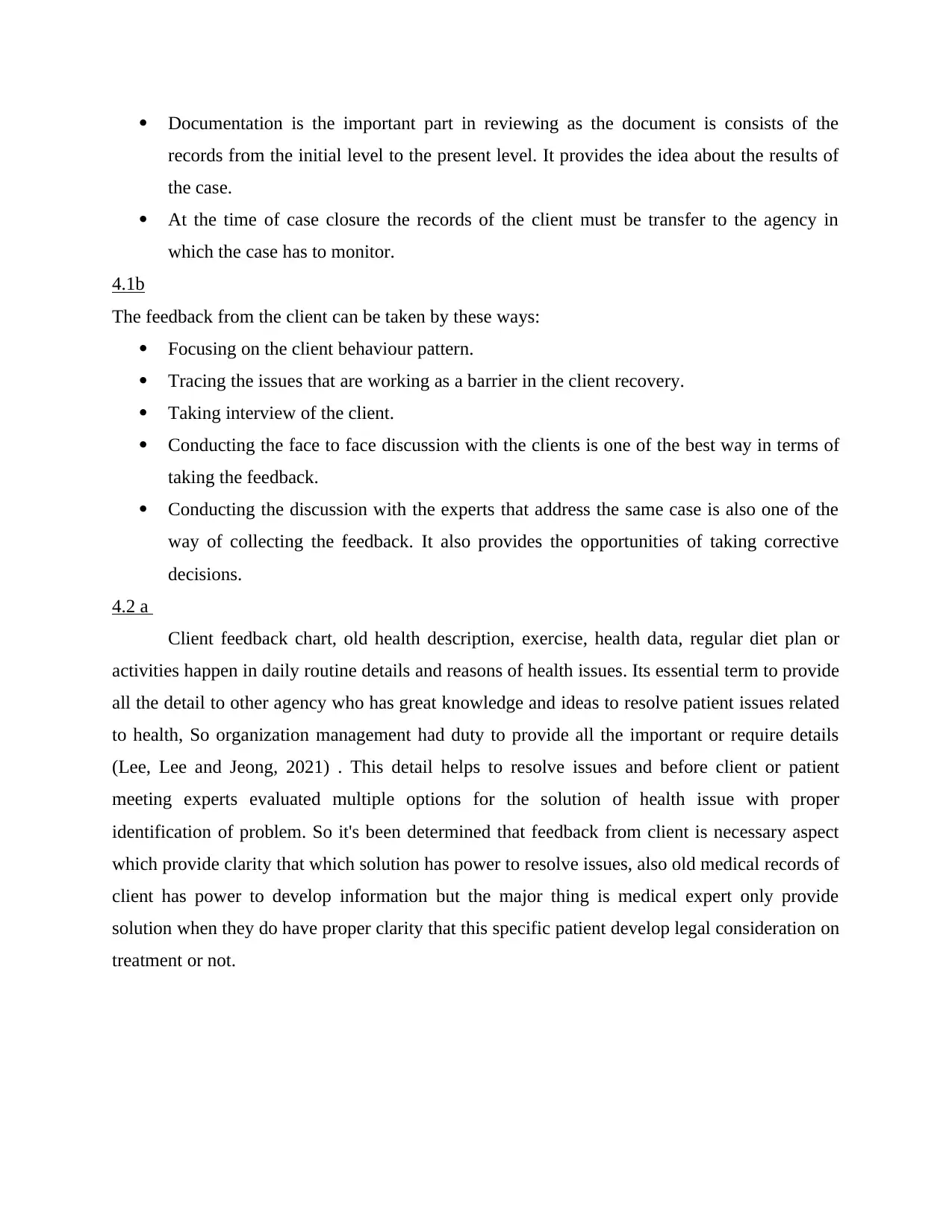
Documentation is the important part in reviewing as the document is consists of the
records from the initial level to the present level. It provides the idea about the results of
the case.
At the time of case closure the records of the client must be transfer to the agency in
which the case has to monitor.
4.1b
The feedback from the client can be taken by these ways:
Focusing on the client behaviour pattern.
Tracing the issues that are working as a barrier in the client recovery.
Taking interview of the client.
Conducting the face to face discussion with the clients is one of the best way in terms of
taking the feedback.
Conducting the discussion with the experts that address the same case is also one of the
way of collecting the feedback. It also provides the opportunities of taking corrective
decisions.
4.2 a
Client feedback chart, old health description, exercise, health data, regular diet plan or
activities happen in daily routine details and reasons of health issues. Its essential term to provide
all the detail to other agency who has great knowledge and ideas to resolve patient issues related
to health, So organization management had duty to provide all the important or require details
(Lee, Lee and Jeong, 2021) . This detail helps to resolve issues and before client or patient
meeting experts evaluated multiple options for the solution of health issue with proper
identification of problem. So it's been determined that feedback from client is necessary aspect
which provide clarity that which solution has power to resolve issues, also old medical records of
client has power to develop information but the major thing is medical expert only provide
solution when they do have proper clarity that this specific patient develop legal consideration on
treatment or not.
records from the initial level to the present level. It provides the idea about the results of
the case.
At the time of case closure the records of the client must be transfer to the agency in
which the case has to monitor.
4.1b
The feedback from the client can be taken by these ways:
Focusing on the client behaviour pattern.
Tracing the issues that are working as a barrier in the client recovery.
Taking interview of the client.
Conducting the face to face discussion with the clients is one of the best way in terms of
taking the feedback.
Conducting the discussion with the experts that address the same case is also one of the
way of collecting the feedback. It also provides the opportunities of taking corrective
decisions.
4.2 a
Client feedback chart, old health description, exercise, health data, regular diet plan or
activities happen in daily routine details and reasons of health issues. Its essential term to provide
all the detail to other agency who has great knowledge and ideas to resolve patient issues related
to health, So organization management had duty to provide all the important or require details
(Lee, Lee and Jeong, 2021) . This detail helps to resolve issues and before client or patient
meeting experts evaluated multiple options for the solution of health issue with proper
identification of problem. So it's been determined that feedback from client is necessary aspect
which provide clarity that which solution has power to resolve issues, also old medical records of
client has power to develop information but the major thing is medical expert only provide
solution when they do have proper clarity that this specific patient develop legal consideration on
treatment or not.
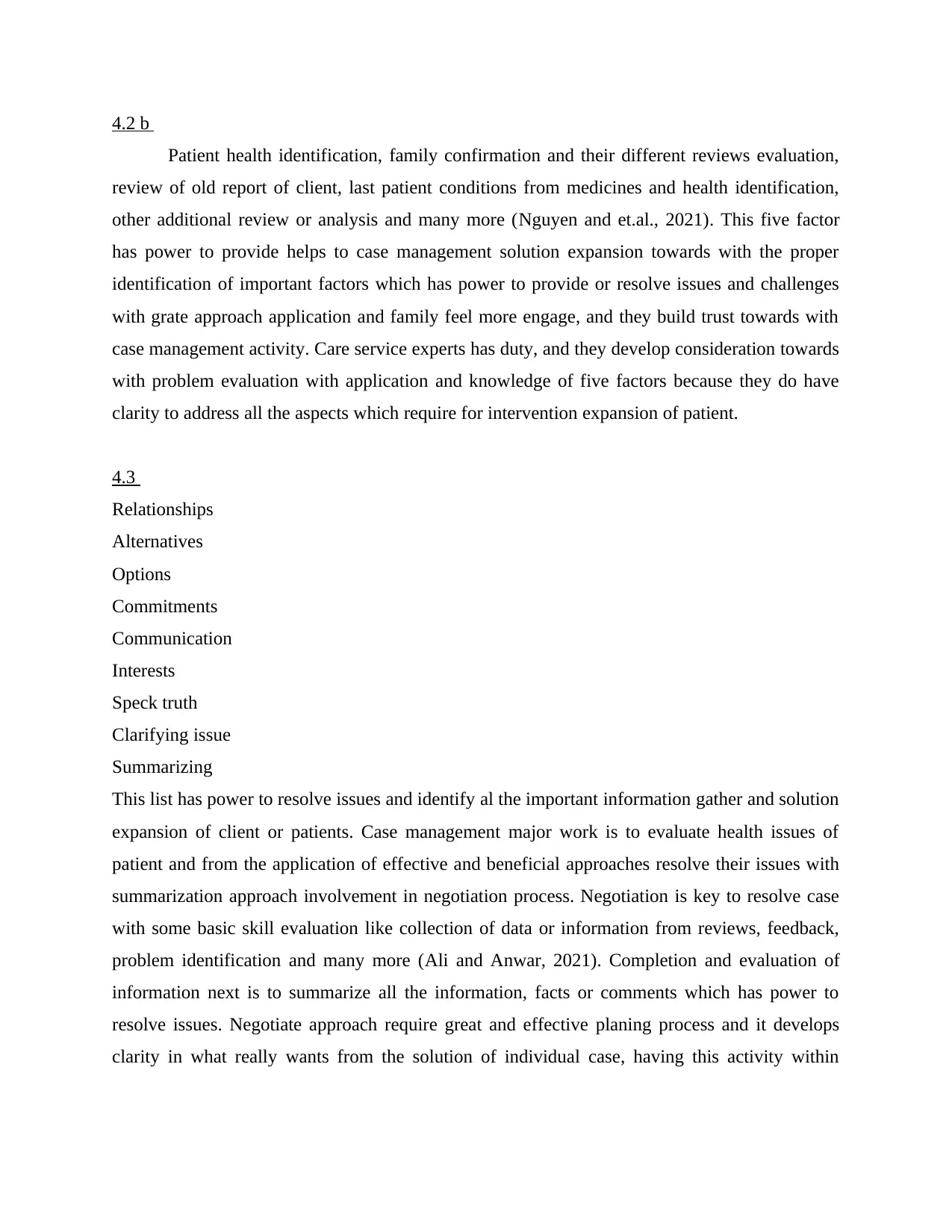
4.2 b
Patient health identification, family confirmation and their different reviews evaluation,
review of old report of client, last patient conditions from medicines and health identification,
other additional review or analysis and many more (Nguyen and et.al., 2021). This five factor
has power to provide helps to case management solution expansion towards with the proper
identification of important factors which has power to provide or resolve issues and challenges
with grate approach application and family feel more engage, and they build trust towards with
case management activity. Care service experts has duty, and they develop consideration towards
with problem evaluation with application and knowledge of five factors because they do have
clarity to address all the aspects which require for intervention expansion of patient.
4.3
Relationships
Alternatives
Options
Commitments
Communication
Interests
Speck truth
Clarifying issue
Summarizing
This list has power to resolve issues and identify al the important information gather and solution
expansion of client or patients. Case management major work is to evaluate health issues of
patient and from the application of effective and beneficial approaches resolve their issues with
summarization approach involvement in negotiation process. Negotiation is key to resolve case
with some basic skill evaluation like collection of data or information from reviews, feedback,
problem identification and many more (Ali and Anwar, 2021). Completion and evaluation of
information next is to summarize all the information, facts or comments which has power to
resolve issues. Negotiate approach require great and effective planing process and it develops
clarity in what really wants from the solution of individual case, having this activity within
Patient health identification, family confirmation and their different reviews evaluation,
review of old report of client, last patient conditions from medicines and health identification,
other additional review or analysis and many more (Nguyen and et.al., 2021). This five factor
has power to provide helps to case management solution expansion towards with the proper
identification of important factors which has power to provide or resolve issues and challenges
with grate approach application and family feel more engage, and they build trust towards with
case management activity. Care service experts has duty, and they develop consideration towards
with problem evaluation with application and knowledge of five factors because they do have
clarity to address all the aspects which require for intervention expansion of patient.
4.3
Relationships
Alternatives
Options
Commitments
Communication
Interests
Speck truth
Clarifying issue
Summarizing
This list has power to resolve issues and identify al the important information gather and solution
expansion of client or patients. Case management major work is to evaluate health issues of
patient and from the application of effective and beneficial approaches resolve their issues with
summarization approach involvement in negotiation process. Negotiation is key to resolve case
with some basic skill evaluation like collection of data or information from reviews, feedback,
problem identification and many more (Ali and Anwar, 2021). Completion and evaluation of
information next is to summarize all the information, facts or comments which has power to
resolve issues. Negotiate approach require great and effective planing process and it develops
clarity in what really wants from the solution of individual case, having this activity within
⊘ This is a preview!⊘
Do you want full access?
Subscribe today to unlock all pages.

Trusted by 1+ million students worldwide
1 out of 26
Related Documents
Your All-in-One AI-Powered Toolkit for Academic Success.
+13062052269
info@desklib.com
Available 24*7 on WhatsApp / Email
![[object Object]](/_next/static/media/star-bottom.7253800d.svg)
Unlock your academic potential
Copyright © 2020–2025 A2Z Services. All Rights Reserved. Developed and managed by ZUCOL.





